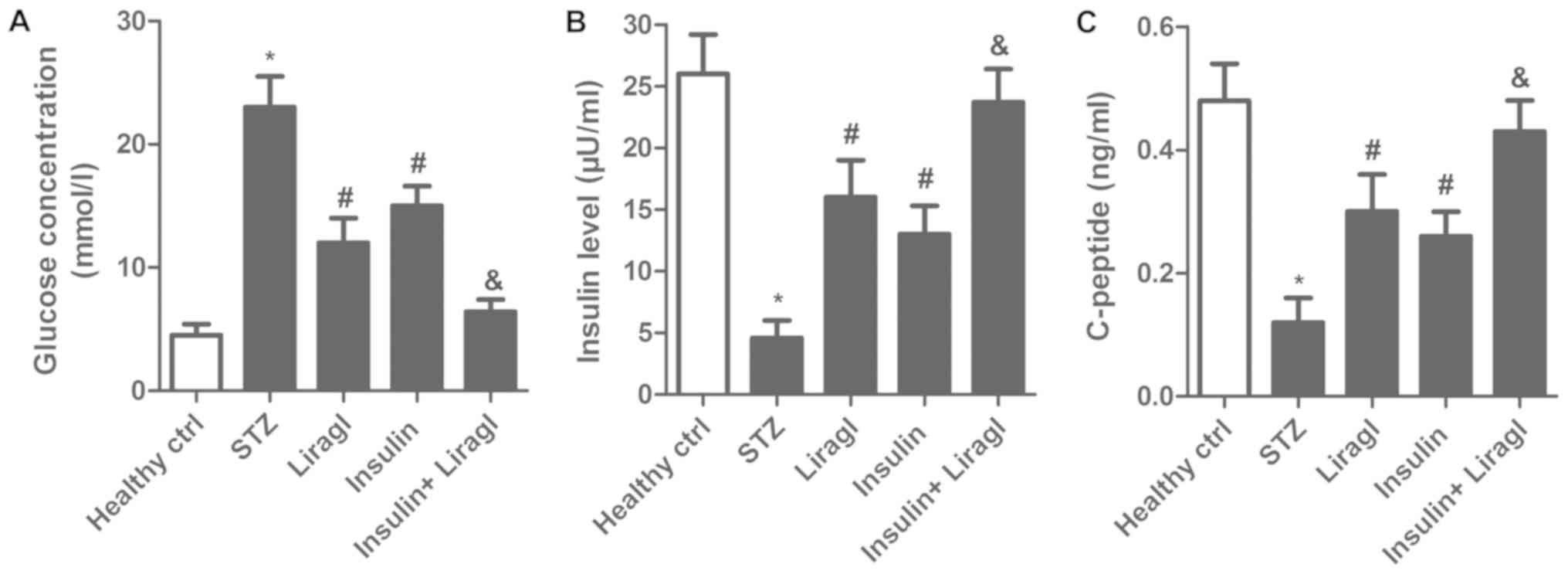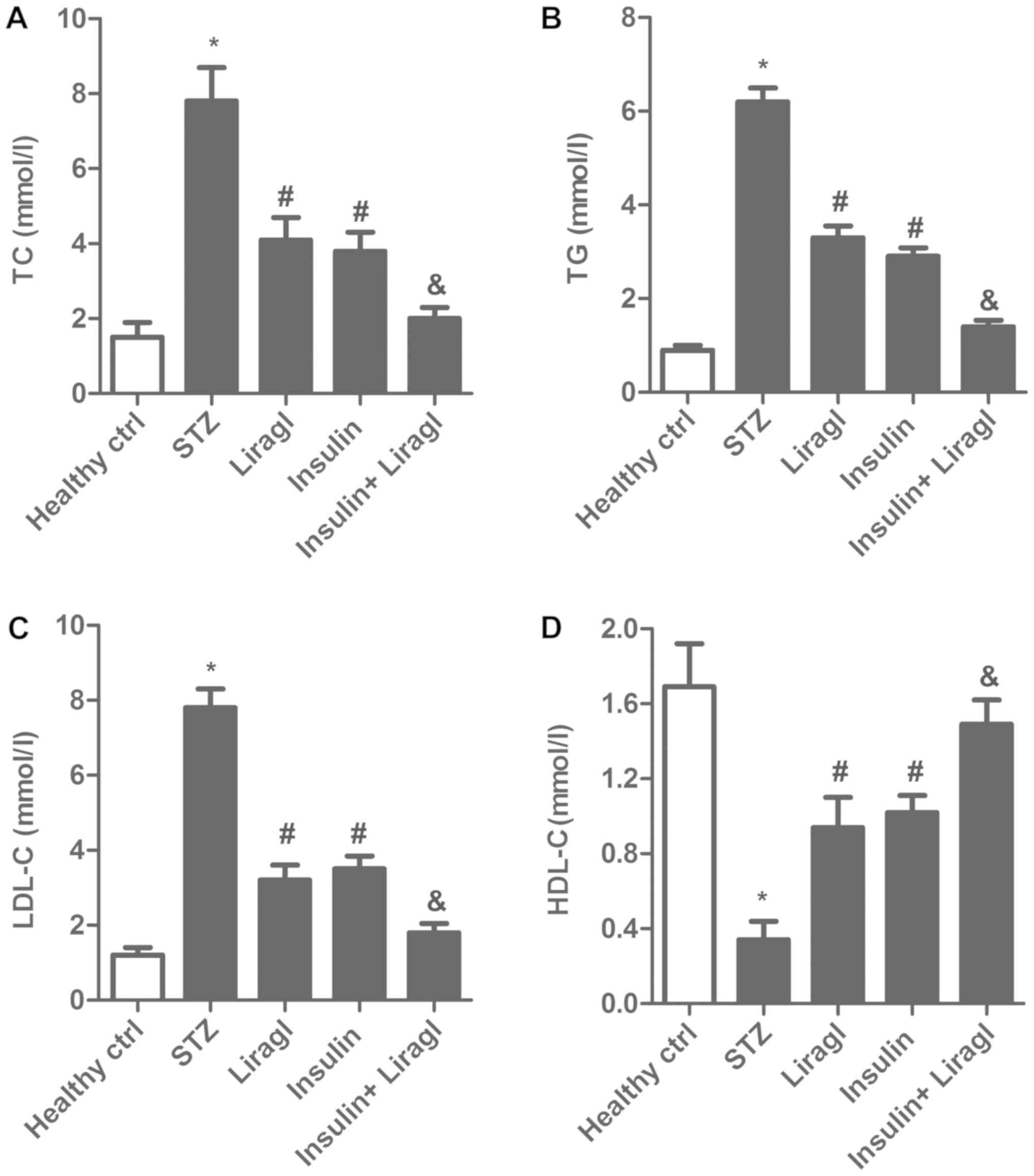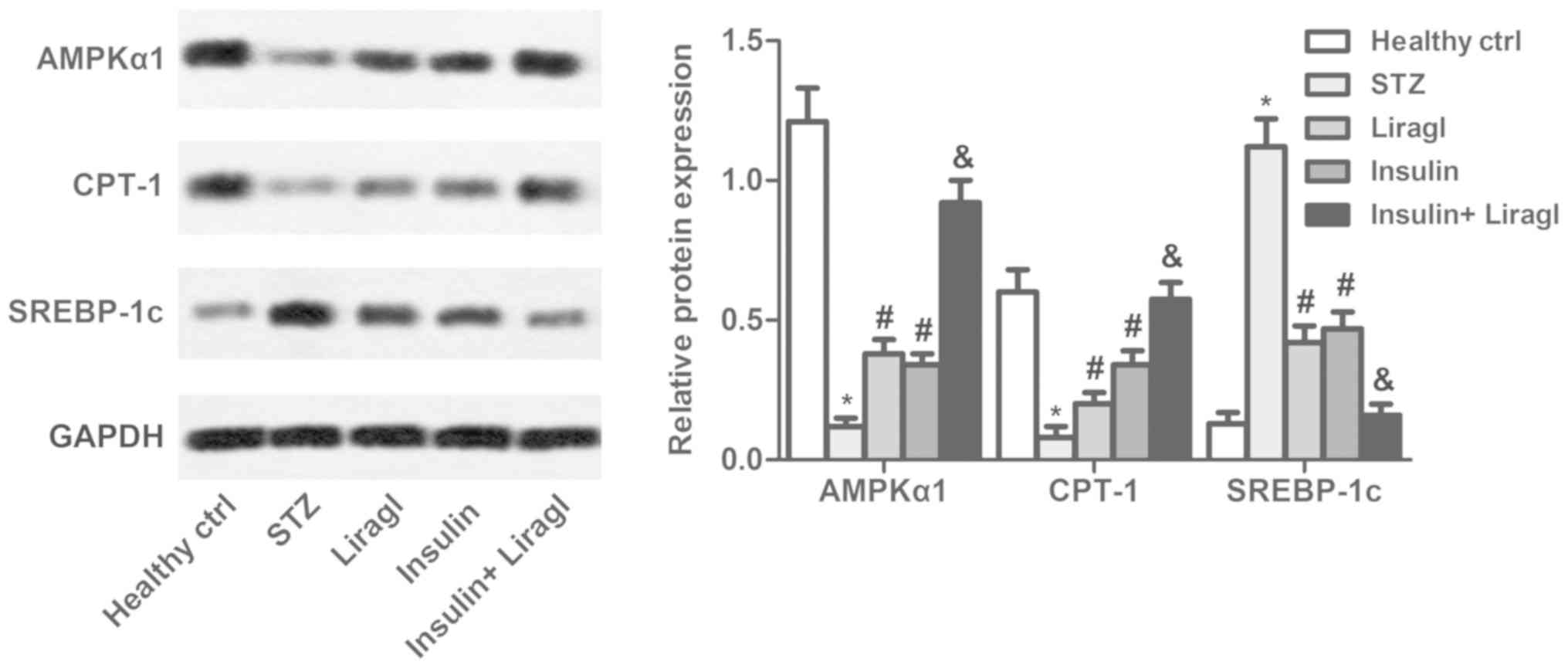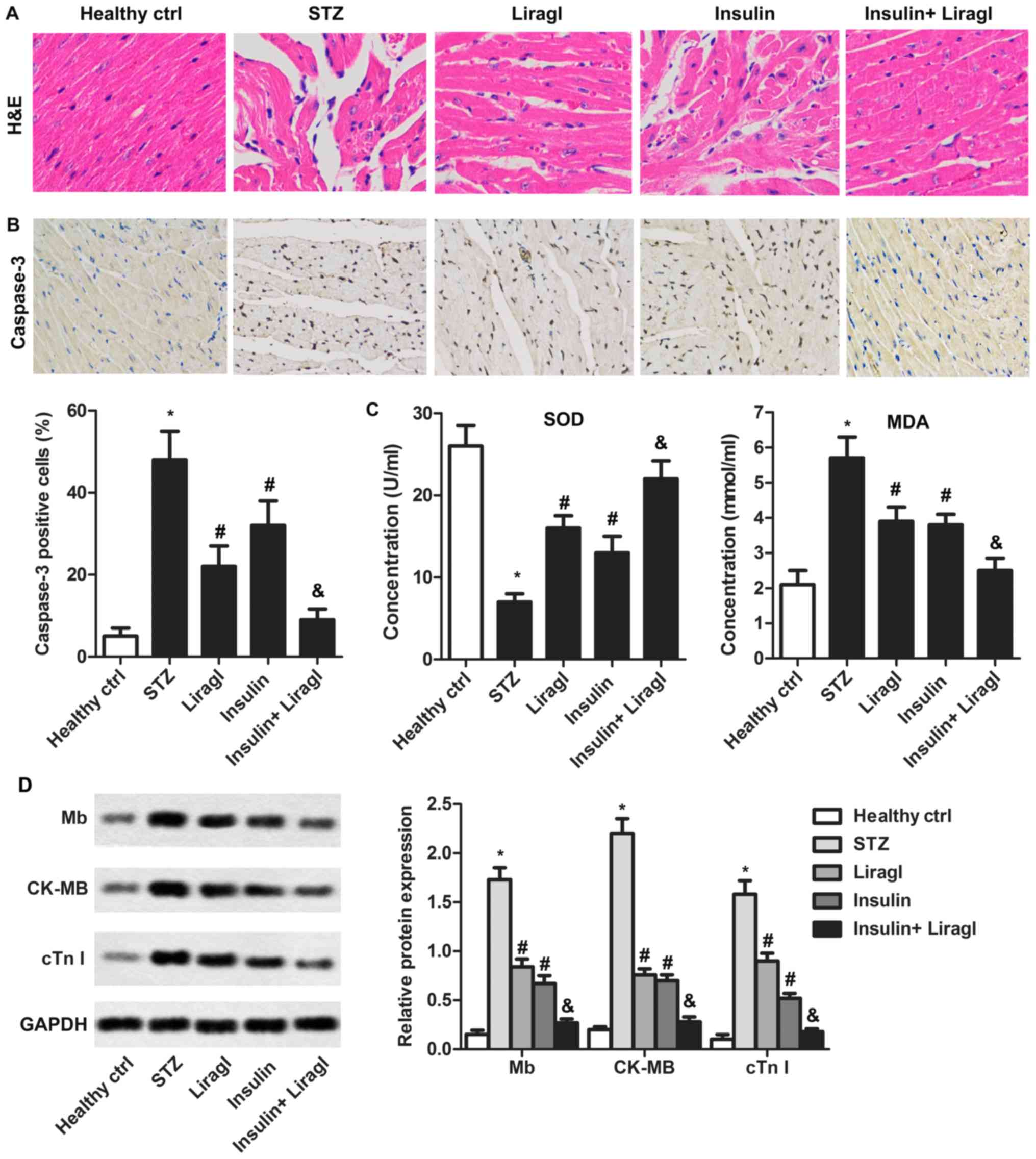|
1
|
Sciatti E, Vizzardi E, Castiello A,
Valentini F, Bonadei I, Gelsomino S, Lorusso R and Metra M: The
role of type 2 diabetes mellitus on hypertensive-related aortic
stiffness. Echocardiography. 35:798–803. 2018. View Article : Google Scholar : PubMed/NCBI
|
|
2
|
Chen H, Jiang Y, Yang Z, Hu W, Xiong L,
Wang N, Liu X, Zheng G, Ouyang K and Wang W: Effects of
chimonanthus nitens oliv. Leaf extract on glycolipid metabolism and
antioxidant capacity in diabetic model mice. Oxid Med Cell Longev.
2017:76485052017. View Article : Google Scholar : PubMed/NCBI
|
|
3
|
Zhang M, Zhou J, Liu Y, Sun X, Luo X, Han
C, Zhang L, Wang B, Ren Y, Zhao Y, et al: Risk of type 2 diabetes
mellitus associated with plasma lipid levels: The rural Chinese
cohort study. Diabetes Res Clin Pract. 135:150–157. 2018.
View Article : Google Scholar : PubMed/NCBI
|
|
4
|
Wang Q, Zhang X, Fang L, Guan Q, Guan L
and Li Q: Prevalence, awareness, treatment and control of diabetes
mellitus among middle-aged and elderly people in a rural Chinese
population: A cross-sectional study. PLoS One. 13:e01983432018.
View Article : Google Scholar : PubMed/NCBI
|
|
5
|
Riemenschneider H, Saha S, van den Broucke
S, Maindal HT, Doyle G, Levin-Zamir D, Muller I, Ganahl K, Sørensen
K, Chang P, et al: State of diabetes self-management education in
the european union member states and Non-EU Countries: The diabetes
literacy project. PLoS One. 2018:14671712018.
|
|
6
|
Davies ML, Pham DQ and Drab SR: GLP1-RA
Add-on therapy in patients with type 2 diabetes currently on a
bolus containing insulin regimen. Pharmacotherapy. 36:893–905.
2016. View Article : Google Scholar : PubMed/NCBI
|
|
7
|
Jiménez-Osorio AS, Monroy A and Alavez S:
Curcumin and insulin resistance-Molecular targets and clinical
evidences. Biofactors. 42:561–580. 2016. View Article : Google Scholar : PubMed/NCBI
|
|
8
|
Neumiller JJ: Differential chemistry
(structure), mechanism of action, and pharmacology of GLP-1
receptor agonists and DPP-4 inhibitors. J Am Pharm Assoc (2003). 49
Suppl 1:S16–S29. 2009. View Article : Google Scholar : PubMed/NCBI
|
|
9
|
Andreozzi F, Raciti GA, Nigro C, Mannino
GC, Procopio T, Davalli AM, Beguinot F, Sesti G, Miele C and Folli
F: The GLP-1 receptor agonists exenatide and liraglutide activate
Glucose transport by an AMPK-dependent mechanism. J Transl Med.
14:2292016. View Article : Google Scholar : PubMed/NCBI
|
|
10
|
Kramer CK, Zinman B, Choi H, Connelly PW
and Retnakaran R: The impact of chronic liraglutide therapy on
glucagon secretion in type 2 diabetes: Insight from the libra
trial. J Clin Endocrinol Metab. 100:3702–3709. 2015. View Article : Google Scholar : PubMed/NCBI
|
|
11
|
Nauck MA: Incretin-based therapies for
type 2 diabetes mellitus: Properties, functions, and clinical
implications. Am J Med. 124 (1 Suppl):S3–S18. 2011. View Article : Google Scholar : PubMed/NCBI
|
|
12
|
Perry RJ, Samuel VT, Petersen KF and
Shulman GI: The role of hepatic lipids in hepatic insulin
resistance and type 2 diabetes. Nature. 510:84–91. 2014. View Article : Google Scholar : PubMed/NCBI
|
|
13
|
Lan YL, Huang SP, Heng XP, Chen L, Li PH,
Wu J, Yang LQ, Pan XD, Lin T, Cheng XL, et al: Dan-gua fang
improves glycolipid metabolic disorders by promoting hepatic
adenosine 5′-monophosphate activated protein kinase expression in
diabetic Goto-Kakizaki rats. Chin J Integr Med. 21:188–195. 2015.
View Article : Google Scholar : PubMed/NCBI
|
|
14
|
Yki-Järvinen H: Management of type 2
diabetes mellitus and cardiovascular risk: Lessons from
intervention trials. Drugs. 60:975–983. 2000. View Article : Google Scholar : PubMed/NCBI
|
|
15
|
Stadler S, Jalili S, Schreib A, Jung B,
Zeman F5, Böger CA, Heid IM and Arzt M; DIACORE study group, :
Association of sleep-disordered breathing with severe chronic
vascular disease in patients with type 2 diabetes. Sleep Med.
48:53–60. 2018. View Article : Google Scholar : PubMed/NCBI
|
|
16
|
Szuszkiewicz-Garcia MM and Davidson JA:
Cardiovascular disease in diabetes mellitus: Risk factors and
medical therapy. Endocrinol Metab Clin North Am. 43:25–40. 2014.
View Article : Google Scholar : PubMed/NCBI
|
|
17
|
Rydén L, Shahim B and Mellbin L: Clinical
implications of cardiovascular outcome trials in type 2 diabetes:
From DCCT to EMPA-REG. Clin Ther. 38:1279–1287. 2016. View Article : Google Scholar : PubMed/NCBI
|
|
18
|
Zhao Q, Yang Y, Chen Z, Yu H and Xu H:
Changes in characteristics, risk factors, and in-hospital mortality
among patients with acute myocardial infarction in the capital of
China over 40 years. Int J Cardiol. 265:30–34. 2018. View Article : Google Scholar : PubMed/NCBI
|
|
19
|
Vilbergsson S, Sigurdsson G, Sigvaldason H
and Sigfusson N: Coronary heart disease mortality amongst
non-insulin-dependent diabetic subjects in Iceland: The independent
effect of diabetes. the reykjavik study 17-year follow up. J Intern
Med. 244:309–316. 1998. View Article : Google Scholar : PubMed/NCBI
|
|
20
|
Maguire GA and Price CP: Kinetic glucose
dehydrogenase method for glucose measurement with a discrete
kinetic analyzer overcomes interference by ascorbate. Clin Chem.
30:157–158. 1984.PubMed/NCBI
|
|
21
|
Zheng H, Fan X, Li X, Zhang Y, Fan Y,
Zhang N, Song Y, Ren F, Shen C, Shen J and Yang J: The association
between single nucleotide polymorphisms of the Apelin gene and
diabetes mellitus in a Chinese population. J Pediatr Endocrinol
Metab. 29:1397–1402. 2016. View Article : Google Scholar : PubMed/NCBI
|
|
22
|
Bally L, Thabit H and Hovorka R:
Glucose-responsive insulin delivery for type 1 diabetes: The
artificial pancreas story. Int J Pharm. 544:309–318. 2018.
View Article : Google Scholar : PubMed/NCBI
|
|
23
|
de Galan BE: Prevention of insulin-induced
hypoglycaemia in the elderly. Ned Tijdschr Geneeskd.
158:A77222014.(In Dutch). PubMed/NCBI
|
|
24
|
Singh S, Wright EE Jr, Kwan AY, Thompson
JC, Syed IA, Korol EE, Waser NA, Yu MB and Juneja R: Glucagon-like
peptide-1 receptor agonists compared with basal insulins for the
treatment of type 2 diabetes mellitus: A systematic review and
meta-analysis. Diabetes Obes Metab. 19:228–238. 2017. View Article : Google Scholar : PubMed/NCBI
|
|
25
|
Chen LN, Lyu J, Yang XF, Ji WJ, Yuan BX,
Chen MX, Ma X and Wang B: Liraglutide ameliorates glycometabolism
and insulin resistance through the upregulation of GLUT4 in
diabetic KKAy mice. Int J Mol Med. 32:892–900. 2013. View Article : Google Scholar : PubMed/NCBI
|
|
26
|
Kalinowska A, Orlińska B, Panasiuk M,
Jamiołkowska M, Zasim A, Florys B, Wojtkielewicz K, Łuczyński W,
Głowińska-Olszewska B and Bossowski A: Assessment of preservation
of beta-cell function in children with long-standing type 1
diabetes with ‘ultrasensitive c-peptide’ method. Pediatr Endocrinol
Diabetes Metab. 23:130–138. 2017. View Article : Google Scholar : PubMed/NCBI
|
|
27
|
Kondo Y, Satoh S, Osada UN and Terauchi Y:
Early liraglutide treatment improves β-cell function in patients
with type 2 diabetes: A retrospective cohort study. Endocr J.
62:971–980. 2015. View Article : Google Scholar : PubMed/NCBI
|
|
28
|
Davis TME, Davis WA and Jeffrey G:
Successful withdrawal of insulin therapy after post-treatment
clearance of hepatitis C virus in a man with type 2 diabetes. Am J
Case Rep. 18:414–417. 2017. View Article : Google Scholar : PubMed/NCBI
|
|
29
|
Schalch DS and Kipnis DM: Abnormalities in
carbohydrate tolerance associated with elevated plasma
nonesterified fatty acids. J Clin Invest. 44:2010–2020. 1965.
View Article : Google Scholar : PubMed/NCBI
|
|
30
|
Liu Y, Jiang X and Chen X: Liraglutide and
Metformin alone or combined therapy for type 2 diabetes patients
complicated with coronary artery disease. Lipids Health Dis.
16:2272017. View Article : Google Scholar : PubMed/NCBI
|
|
31
|
Latha R, Shanthi P and Sachdanandam P:
Kalpaamruthaa modulates oxidative stress in cardiovascular
complication associated with type 2 diabetes mellitus through
PKC-β/Akt signaling. Can J Physiol Pharmacol. 91:901–912. 2013.
View Article : Google Scholar : PubMed/NCBI
|
|
32
|
Kumarathurai P, Anholm C, Nielsen OW,
Kristiansen OP, Mølvig J, Madsbad S, Haugaard SB and Sajadieh A:
Effects of the glucagon-like peptide-1 receptor agonist liraglutide
on systolic function in patients with coronary artery disease and
type 2 diabetes: A randomized double-blind placebo-controlled
crossover study. Cardiovasc Diabetol. 15:1052016. View Article : Google Scholar : PubMed/NCBI
|
|
33
|
Okerson T and Chilton RJ: The
cardiovascular effects of GLP-1 receptor agonists. Cardiovasc Ther.
30:e146–e155. 2012. View Article : Google Scholar : PubMed/NCBI
|
|
34
|
Zhang JY, Wang XY and Wang X: Effects of
liraglutide on hemodynamic parameters in patients with heart
failure. Oncotarget. 8:62693–62702. 2017.PubMed/NCBI
|
|
35
|
Chen T, Ding G, Jin Z, Wagner MB and Yuan
Z: Insulin ameliorates miR-1-induced injury in H9c2 cells under
oxidative stress via Akt activation. Mol Cell Biochem. 369:167–174.
2012. View Article : Google Scholar : PubMed/NCBI
|
|
36
|
Li J, Lin J, Song Y, Xiang L and Wu Z:
Effects of insulin-like growth factor-1 on the myocardium in
diabetic rats. Zhonghua Yi Xue Za Zhi. 94:3329–3333. 2014.(In
Chinese). PubMed/NCBI
|
|
37
|
Xing Y, Sun W, Wang Y, Gao F and Ma H:
Mutual inhibition of insulin signaling and PHLPP-1 determines
cardioprotective efficiency of Akt in aged heart. Aging (Albany
NY). 8:873–888. 2016. View Article : Google Scholar : PubMed/NCBI
|
|
38
|
Cai L, Li W, Wang G, Guo L, Jiang Y and
Kang YJ: Hyperglycemia-induced apoptosis in mouse myocardium:
Mitochondrial cytochrome C-mediated caspase-3 activation pathway.
Diabetes. 51:1938–1948. 2002. View Article : Google Scholar : PubMed/NCBI
|
|
39
|
De L, eón DD, Crutchlow MF, Ham JY and
Stoffers DA: Role of glucagon-like peptide-1 in the pathogenesis
and treatment of diabetes mellitus. Int J Biochem Cell Biol.
38:845–859. 2006. View Article : Google Scholar : PubMed/NCBI
|
|
40
|
Chen J, Wang Z, Mao Y, Zheng Z, Chen Y,
Khor S, Shi K, He Z, Li J, Gong F, et al: Liraglutide activates
autophagy via GLP-1R to improve functional recovery after spinal
cord injury. Oncotarget. 8:85949–85968. 2017.PubMed/NCBI
|
|
41
|
Qi Q, Lu L, Li H, Yuan Z, Chen G, Lin M,
Ruan Z, Ye X, Xiao Z and Zhao Q: Spatiotemporal delivery of
nanoformulated liraglutide for cardiac regeneration after
myocardial infarction. Int J Nanomedicine. 12:4835–4848. 2017.
View Article : Google Scholar : PubMed/NCBI
|
|
42
|
Xu T, Liu Y, Deng Y, Meng J, Li P, Xu X
and Zeng J: Insulin combined with selenium inhibit p38MAPK/CBP
pathway and suppresses cardiomyocyte apoptosis in rats with
diabetic cardiomyopathy. Xi Bao Yu Fen Zi Mian Yi Xue Za Zhi.
32:926–930. 2016.(In Chinese). PubMed/NCBI
|
|
43
|
Min Q, Bai Y, Zhang Y, Yu W, Zhang M, Liu
D, Diao T and Lv W: Hawthorn leaf flavonoids protect against
diabetes-induced cardiomyopathy in rats via PKC-α signaling
pathway. Evid Based Complement Alternat Med. 2017:20719522017.
View Article : Google Scholar : PubMed/NCBI
|
|
44
|
Bresciani G, da Cruz IB and
González-Gallego J: Manganese superoxide dismutase and oxidative
stress modulation. Adv Clin Chem. 68:87–130. 2015. View Article : Google Scholar : PubMed/NCBI
|
|
45
|
Ayala A, Muñoz MF and Argüelles S: Lipid
peroxidation: Production, metabolism, and signaling mechanisms of
malondialdehyde and 4-hydroxy-2-nonenal. Oxid Med Cell Longev.
2014:3604382014. View Article : Google Scholar : PubMed/NCBI
|
|
46
|
Gao H, Zeng Z, Zhang H, Zhou X, Guan L,
Deng W and Xu L: The glucagon-like peptide-1 analogue liraglutide
inhibits oxidative stress and inflammatory response in the liver of
rats with diet-induced non-alcoholic fatty liver disease. Biol
Pharm Bull. 38:694–702. 2015. View Article : Google Scholar : PubMed/NCBI
|
|
47
|
Ramalingayya GV, Sonawane V, Cheruku SP,
Kishore A, Nayak PG, Kumar N, VShenoy RS and Nandakumar K: Insulin
protects against brain oxidative stress with an apparent effect on
episodic memory in doxorubicin-induced cognitive dysfunction in
wistar rats. J Environ Pathol Toxicol Oncol. 36:121–130. 2017.
View Article : Google Scholar : PubMed/NCBI
|


















